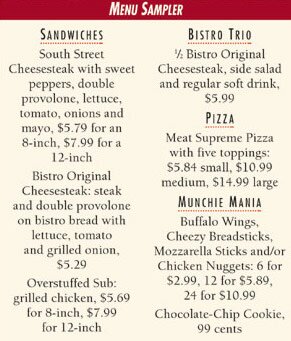|
Light Moves
Neon, halogen and incandescent fixtures combine to make Jerry's Subs a knockout at night.
By Lisa Bertagnoli
By day, the Jerry’s Subs and Pizza restaurant in Ashburn, Va., looks like a fast-casual restaurant, albeit a high-style one. There’s a colorful menu board, vast expanses of stainless steel, a red-and-white tiled floor, and a variety of table- and bar-height seats. A strip of purple neon races around the ceiling, but it’s barely noticeable in the strong sunlight.
At night, that purple neon comes out to play. It glows against the stainless steel and smoky mirrors, creating an exciting interior that beckons to outsiders. “It looks like a martini bar,” says Dave Terzian, executive vice president and operating partner at Gaithersburg, Md.-based Jerry’s.
“It ought to make you feel thumpy,” agrees designer Travis Price, referring to the vibrations of a stereo’s subwoofer.
Jerry’s executives intended to create neither martini bar nor thumpy feeling when they remodeled the 50-year-old concept, but they did want to create an interior that felt exciting and compelling to its main demographic, 18- to 44-year-old males. “We wanted the stores to convey a serious but hip image,” says Terzian.
 Natural Touches Natural Touches
Preparations for the redesign began two years ago, “because it was time,” Terzian confesses. “It’s our first total new look in 15 years.”
In its most recent incarnation, Jerry’s interior, a mélange of beiges, reds and greens, looked more like a staid company cafeteria than an exciting fast-casual restaurant concept. “It wasn’t bad, but it was bland,” says Terzian.
Executives and designer Price first reduced the building size to about 1,800 square feet from a high of 3,600 square feet, then reworked the kitchen to make the back of the house smaller and the front of the house bigger. As a result, the restaurants have as many seats as the older version, Terzian says.
In the dining room, they replaced the old laminate and vinyl with more natural finishes such as maple, cork, glass, ceramics and metal. They chose a color scheme of red, white and purple to reflect the colors of Jerry’s logo.
 Terzian terms the new look “soft modern industrial,” but in some ways, it harks back to the early days of fast food. The floor is red and white tile. The paneling behind the menu board is banded stainless steel. A counter that gives a view of the open kitchen recalls soda fountains of years past. Terzian terms the new look “soft modern industrial,” but in some ways, it harks back to the early days of fast food. The floor is red and white tile. The paneling behind the menu board is banded stainless steel. A counter that gives a view of the open kitchen recalls soda fountains of years past.
More contemporary touches include the use of cork, meant as flooring material, as wainscoting. The soft brown finish balances the bright stainless steel in the room and is immune to kicks, bumps and other abuses, Terzian says. “It’s eight or 10 bucks a foot, which is not cheap. But it lasts forever, and it’s warm,” he says.
Following the fast-casual formula, seats are both bar- and table-height to create visual interest. Color-tinted black-and-white photographs of Washington scenes, snapped by local photographer Ken Wyner, assure customers that Jerry’s is indeed a local business.
Bump in the Night
The first remodeled unit opened in Aspen Hill, Md., in August 2002. Since then, the prototype has undergone a few cosmetic changes.
In the original design, the purple neon and glass panels near the entryway were encased by perforated stainless-steel valances. “It was a nice look, like an exquisite light fixture,” Price says. That nice look, however, cost a few thousand dollars per store, so the valances were banished.
 Neon was installed above the menu board to draw attention to that area. Bar stops were added to the stainless steel behind the board to add textural interest. Because the stark white of the red-and-white floor tiles proved a dirt magnet, the white was changed to creamy gray. Neon was installed above the menu board to draw attention to that area. Bar stops were added to the stainless steel behind the board to add textural interest. Because the stark white of the red-and-white floor tiles proved a dirt magnet, the white was changed to creamy gray.
Jerry’s executives also found a commercial supplier for the copper-cloth light fixtures that hang from the ceiling. The shades look more uniform and more refined than their handmade predecessors.
Even without the slight changes, the redesign did and is doing wonders for sales, Terzian says. A remodeled restaurant needs a 5 percent bump in sales to cover the cost of the redesign, which runs between $65,000 and $90,000 for a remodel and about $300,000 for a new store, real estate not included.
To date, sales at a remodeled store in Lanham, Md., have jumped by 50 percent during evening hours, thanks to that martini-bar look, which sells more pizza, Terzian explains. Other remodeled restaurants have seen sales increases of 15 and 20 percent. “It varies, but it’s all very positive,” he says.
The redesign is even attracting new franchisees to the system, among them Patricia Carr and Christopher Markwood, who own the Ashburn, Va., location. “We really like the look,” Carr says.
|

